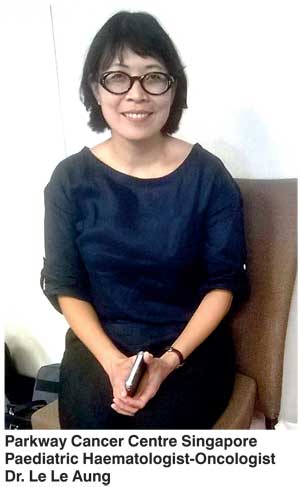Wednesday Dec 17, 2025
Wednesday Dec 17, 2025
Monday, 12 June 2017 01:36 - - {{hitsCtrl.values.hits}}
Text and pic by Fathima Riznaz Hafi
In an exclusive interview with Daily FT at Parkway Cancer Centre (PCC) Singapore recently, Paediatric Haematologist-Oncologist Dr. Le Le Aung shared a reassuring fact that children tolerate cancer treatment including chemotherapy far better than adults.
“Parents are understandably terrified when their children are diagnosed with this illness and dread having to put them  through cancer treatment as they are so small but many don’t know that children actually tolerate chemotherapy much better than adults. This is because their organs are very young. They have a very strong chance of cure. Parents also need to know that cancer does not equal death – it is curable,” she said.
through cancer treatment as they are so small but many don’t know that children actually tolerate chemotherapy much better than adults. This is because their organs are very young. They have a very strong chance of cure. Parents also need to know that cancer does not equal death – it is curable,” she said.
Dr. Aung treats children with cancers which include leukaemia, lymphoma, retinoblastoma, brain tumour and bone tumour. Her work also involves treating children with diseases that affect the production of blood and its components, such as blood cells, haemoglobin, bone marrow, platelets, blood vessels and spleen. Such diseases include haemophilia, thalassaemia, blood clots, other bleeding disorders and blood cancers.
At the interview she spoke at length about childhood leukaemia, signs parents need to be wary of and the treatment which could save them.
“Across the world, including Sri Lanka, leukaemia is the most common type of cancer among children. It is however highly curable with 90% chance of recovery. Sri Lanka has a fair number of cases and when I visited Colombo some time back, I was pleased to note the easy access to cancer care,” she said.
Leukaemia is a cancer of the white blood cells. We have several different types of white blood cells in our bodies but two of the most predominant are the lymphocytes and neutrophils. Their function is to work together to fight infection. White blood cells repair and reproduce themselves in a controlled manner but in leukaemia the cells continue to divide, without maturing. These immature cells attack the bone marrow and therefore the cells that the bone marrow makes do not come out normally. Since the immature cells can’t function properly they are unable to fight infections. Also, they crowd out the production capacity of the bone marrow, preventing healthy red blood cells required to carry oxygen and platelets to stop bleeding, from being produced.
“You then start to see a difference in the child. They look pale, they bleed easily and you see big bruises. It is normal to see children with bruises and bleeding because they run and play and fall all the time but this is bruising and bleeding that is out of the ordinary. They get tired easily, are lethargic, get prolonged fever and are not as active as the usual kid. They are also more prone to infections because of the compromised white blood cells and may generally feel unwell and complain of aches and pains. The lymph nodes are usually swollen throughout the body. These are all symptoms that a parent has to look out for,” she cautioned.
“Blood tests can be carried out to diagnose leukaemia – if the blood test shows large numbers of abnormal white blood cells and low numbers of normal white blood cells, red blood cells or platelets – the suspicion falls on leukaemia. The ‘Bone Marrow Test’ is the confirmation of leukaemia. This test can help work out which type of leukaemia the patient has,” she said.
It confirms a blood cancer diagnosis or a bone marrow disorder, evaluates the patient’s response to therapy and helps track progress during treatment.
After leukaemia is diagnosed and tests have been done to confirm the type of leukaemia, treatment must commence. The main treatment for childhood leukaemia is chemotherapy.
“Chemotherapy can be given through the vein (injection), orally (tablets) or spine (injection). Injecting chemotherapy drugs directly into the cerebrospinal fluid (CSF) is necessary for some types of brain cancer,” Dr. Aung said.
Intensive leukaemia chemotherapy has certain side effects, including hair loss, nausea and vomiting, and increased risk for infection or bleeding in the short term. Other treatment such as targeted drugs, surgery and radiation therapy may be used in special circumstances.
Dr. Aung concluded saying that children have different blood disorders and cancers from adults, reiterating that children also tolerate treatment differently from adults, thus urging parents to seek help as soon as symptoms are evident and not to fear commencement of treatment as their children are a lot stronger than they think, are far better at tolerating chemotherapy and therefore stand a better chance of recovery as long as treatment is sought early.